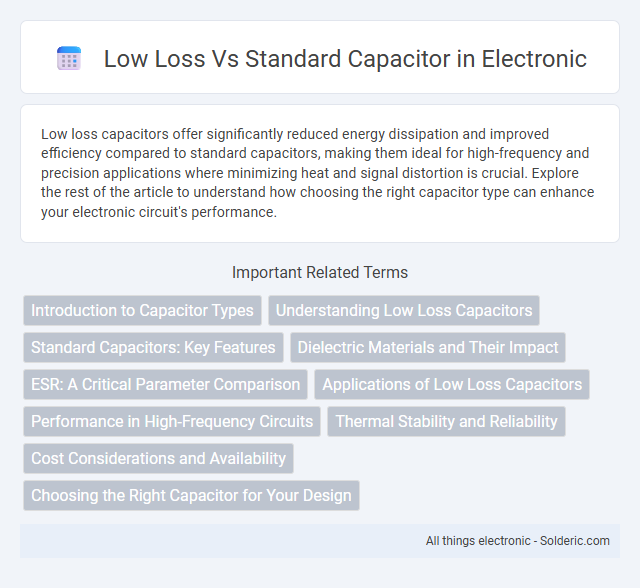Low loss capacitors offer significantly reduced energy dissipation and improved efficiency compared to standard capacitors, making them ideal for high-frequency and precision applications where minimizing heat and signal distortion is crucial. Explore the rest of the article to understand how choosing the right capacitor type can enhance your electronic circuit's performance.
Comparison Table
| Feature | Low Loss Capacitor | Standard Capacitor |
|---|---|---|
| Dielectric Material | High-quality, low dissipation factor dielectric | Common dielectrics with higher dissipation factor |
| Dissipation Factor (tan d) | Very low (<0.001) | Higher (0.01 to 0.05) |
| Energy Loss | Minimal energy dissipation | Higher power loss during operation |
| Frequency Performance | Optimized for high-frequency applications | Suitable for general frequency ranges |
| Applications | Precision circuits, RF, filters, oscillators | General-purpose electronics |
| Cost | Higher due to advanced materials | Lower cost, mass-produced |
| Reliability | Enhanced stability and lifespan | Standard reliability |
Introduction to Capacitor Types
Low loss capacitors are engineered to minimize energy dissipation, featuring high-quality dielectric materials like C0G/NP0 ceramics or polypropylene film, whereas standard capacitors often utilize materials such as X7R or Y5V that have higher dielectric losses. These low loss types offer improved performance in high-frequency applications, maintaining stable capacitance and reducing heat generation compared to standard capacitors. Selecting the appropriate capacitor type directly impacts circuit efficiency, signal integrity, and long-term reliability in electronic designs.
Understanding Low Loss Capacitors
Low loss capacitors exhibit significantly lower equivalent series resistance (ESR) compared to standard capacitors, resulting in improved efficiency and reduced heat generation during operation. These capacitors are ideal for high-frequency applications and precision circuits where minimizing energy loss and maintaining signal integrity are critical. Understanding the benefits of low loss capacitors can help you select components that enhance performance and reliability in your electronic designs.
Standard Capacitors: Key Features
Standard capacitors typically exhibit higher equivalent series resistance (ESR) and dielectric losses compared to low loss capacitors, impacting efficiency and heat generation in high-frequency applications. They are commonly made with materials like ceramic, electrolytic, or film dielectrics, offering a balance between cost and performance. Standard capacitors are widely used in general-purpose electronic circuits where minimal loss is not critical.
Dielectric Materials and Their Impact
Low loss capacitors utilize advanced dielectric materials such as C0G/NP0 ceramic or polypropylene film, which exhibit minimal energy dissipation and superior stability under varying frequencies and temperatures. Standard capacitors often employ dielectrics like X7R or Y5V ceramics, which have higher dielectric losses and poorer tolerance, affecting performance in high-frequency or precision circuits. The choice of dielectric material crucially impacts the capacitor's equivalent series resistance (ESR), dielectric absorption, and overall efficiency in electronic applications.
ESR: A Critical Parameter Comparison
Low loss capacitors exhibit significantly lower Equivalent Series Resistance (ESR) compared to standard capacitors, which directly enhances their efficiency in high-frequency applications. Reduced ESR minimizes heat generation and energy dissipation, leading to improved performance and longer lifespan in circuits such as RF filters and power supplies. Selecting capacitors with low ESR is crucial for optimizing signal integrity and maintaining stable voltage levels under dynamic load conditions.
Applications of Low Loss Capacitors
Low loss capacitors are essential in high-frequency and precision electronic applications, such as RF circuits, oscillators, and filters, where minimal energy dissipation is crucial for maintaining signal integrity. These capacitors are also preferred in medical devices and aerospace systems due to their superior stability and reliability under varying environmental conditions. Their low dielectric loss makes them ideal for use in resonant circuits and high-Q applications requiring consistent performance and reduced thermal stress.
Performance in High-Frequency Circuits
Low loss capacitors exhibit superior performance in high-frequency circuits due to their reduced equivalent series resistance (ESR) and minimized dielectric losses, which enhance signal integrity and energy efficiency. Standard capacitors typically generate higher losses and heat, leading to signal distortion and reduced circuit reliability at high frequencies. Selecting a low loss capacitor improves Your circuit's overall stability and frequency response, crucial for RF and microwave applications.
Thermal Stability and Reliability
Low loss capacitors exhibit superior thermal stability due to their low dielectric dissipation factor, which minimizes heat generation during operation and reduces performance degradation over time. Their enhanced reliability stems from consistent capacitance values under varying temperature conditions, ensuring stable circuit functionality in critical applications. Choosing low loss capacitors can improve Your system's longevity and maintain optimal performance even in demanding thermal environments.
Cost Considerations and Availability
Low loss capacitors typically have higher initial costs compared to standard capacitors due to advanced dielectric materials and manufacturing processes. Standard capacitors are more widely available and cost-effective, making them suitable for bulk applications with less stringent performance demands. Availability of low loss capacitors may be limited to specialized suppliers, affecting lead times and procurement strategies.
Choosing the Right Capacitor for Your Design
Low loss capacitors minimize energy dissipation and enhance efficiency by reducing dielectric and equivalent series resistance (ESR), making them ideal for high-frequency and precision applications. Standard capacitors, while more cost-effective, may exhibit higher losses and thermal instability, which can impact circuit performance and reliability under demanding conditions. Selecting the right capacitor for your design requires balancing factors such as frequency response, tolerance, and long-term stability to ensure optimal operation and longevity.
Low loss vs standard capacitor Infographic

 solderic.com
solderic.com